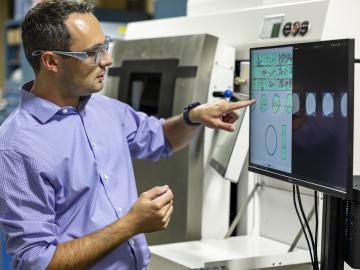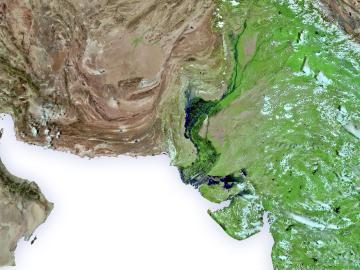Filter News
Area of Research
- (-) Advanced Manufacturing (34)
- (-) Biology and Environment (177)
- (-) National Security (79)
- (-) Supercomputing (311)
- Biological Systems (18)
- Biology and Soft Matter (5)
- Building Technologies (12)
- Chemical and Engineering Materials (4)
- Chemistry and Physics at Interfaces (11)
- Clean Energy (522)
- Climate and Environmental Systems (14)
- Computational Biology (6)
- Computational Chemistry (5)
- Computational Engineering (5)
- Computer Science (19)
- Data (1)
- Earth Sciences (1)
- Electricity and Smart Grid (3)
- Energy Frontier Research Centers (14)
- Energy Sciences (5)
- Fossil Energy (3)
- Fuel Cycle Science and Technology (3)
- Functional Materials for Energy (16)
- Fusion and Fission (54)
- Fusion Energy (17)
- Geographic Information Science and Technology (3)
- Isotope Development and Production (3)
- Isotopes (35)
- Materials (433)
- Materials Characterization (2)
- Materials for Computing (36)
- Materials Synthesis from Atoms to Systems (13)
- Materials Under Extremes (12)
- Mathematics (1)
- Neutron Data Analysis and Visualization (4)
- Neutron Science (190)
- Nuclear Science and Technology (74)
- Nuclear Systems Modeling, Simulation and Validation (3)
- Nuclear Systems Technology (1)
- Quantum Condensed Matter (4)
- Quantum information Science (9)
- Reactor Technology (1)
- Renewable Energy (4)
- Sensors and Controls (5)
- Transportation Systems (11)
News Type
News Topics
- 3-D Printing/Advanced Manufacturing (35)
- Advanced Reactors (4)
- Artificial Intelligence (50)
- Big Data (28)
- Bioenergy (50)
- Biology (76)
- Biomedical (28)
- Biotechnology (14)
- Buildings (6)
- Chemical Sciences (14)
- Clean Water (11)
- Climate Change (53)
- Composites (8)
- Computer Science (112)
- Coronavirus (24)
- Critical Materials (4)
- Cybersecurity (23)
- Decarbonization (23)
- Energy Storage (12)
- Environment (103)
- Exascale Computing (24)
- Frontier (28)
- Fusion (4)
- Grid (13)
- High-Performance Computing (53)
- Hydropower (8)
- Isotopes (2)
- Machine Learning (27)
- Materials (30)
- Materials Science (28)
- Mathematics (3)
- Mercury (7)
- Microscopy (16)
- Molten Salt (1)
- Nanotechnology (16)
- National Security (35)
- Net Zero (3)
- Neutron Science (19)
- Nuclear Energy (10)
- Partnerships (8)
- Physics (9)
- Polymers (4)
- Quantum Computing (19)
- Quantum Science (25)
- Renewable Energy (1)
- Security (14)
- Simulation (23)
- Software (1)
- Space Exploration (4)
- Summit (46)
- Sustainable Energy (40)
- Transformational Challenge Reactor (2)
- Transportation (10)
Media Contacts

The world’s first exascale supercomputer will help scientists peer into the future of global climate change and open a window into weather patterns that could affect the world a generation from now.

While completing his undergraduate studies in the Philippines, atmospheric chemist Christian Salvador caught a glimpse of the horizon. What he saw concerned him: a thin, black line hovering above the city.

The Department of Energy’s Office of Science has allocated supercomputer access to a record-breaking 75 computational science projects for 2024 through its Innovative and Novel Computational Impact on Theory and Experiment, or INCITE, program. DOE is awarding 60% of the available time on the leadership-class supercomputers at DOE’s Argonne and Oak Ridge National Laboratories to accelerate discovery and innovation.

Scientists at ORNL used their expertise in quantum biology, artificial intelligence and bioengineering to improve how CRISPR Cas9 genome editing tools work on organisms like microbes that can be modified to produce renewable fuels and chemicals.

Hilda Klasky, an R&D staff member in the Scalable Biomedical Modeling group at ORNL, has been selected as a senior member of the Association of Computing Machinery, or ACM.

A type of peat moss has surprised scientists with its climate resilience: Sphagnum divinum is actively speciating in response to hot, dry conditions.

Researchers at the Department of Energy’s Oak Ridge National Laboratory have improved flaw detection to increase confidence in metal parts that are 3D-printed using laser powder bed fusion.

As vehicles gain technological capabilities, car manufacturers are using an increasing number of computers and sensors to improve situational awareness and enhance the driving experience.

Using neutrons to see the additive manufacturing process at the atomic level, scientists have shown that they can measure strain in a material as it evolves and track how atoms move in response to stress.

A new study by researchers at the Department of Energy’s Oak Ridge National Laboratory looks at some of the influences that could be driving the increasingly severe weather over Pakistan.




